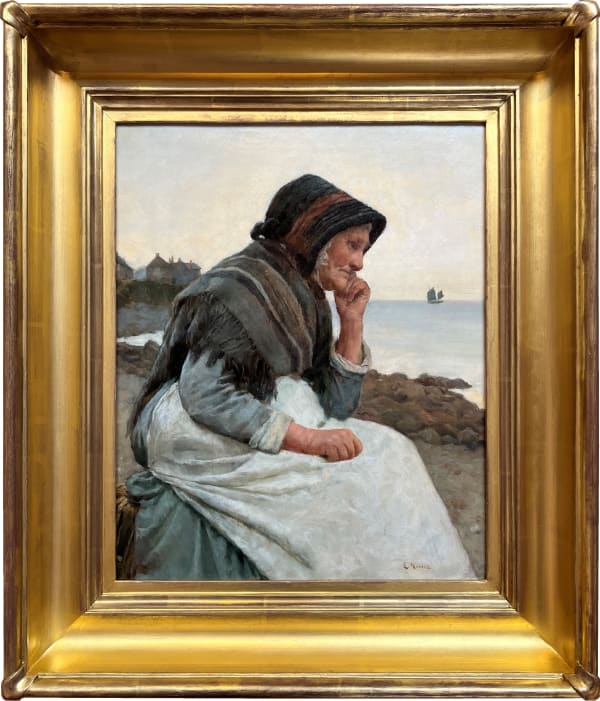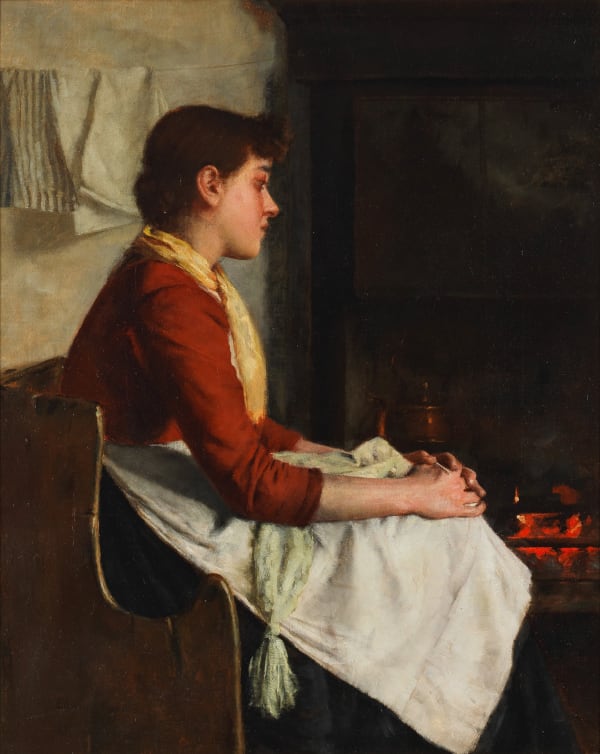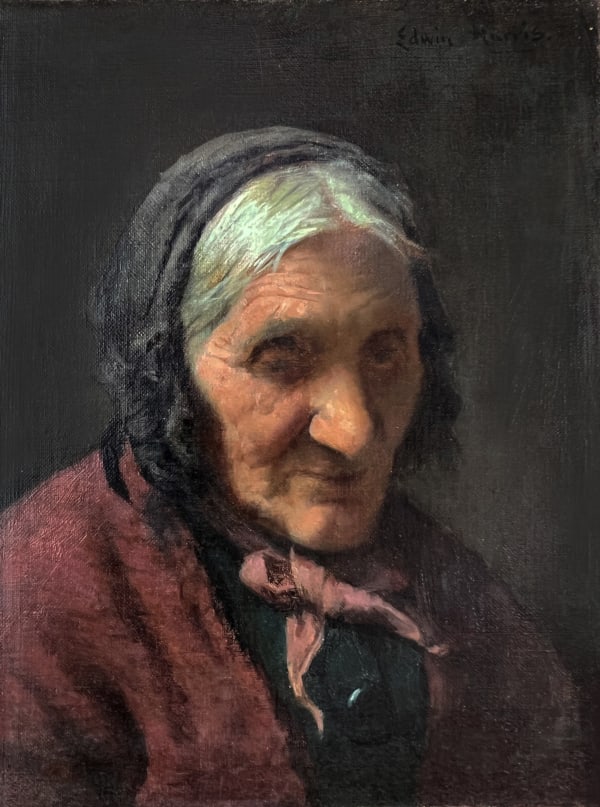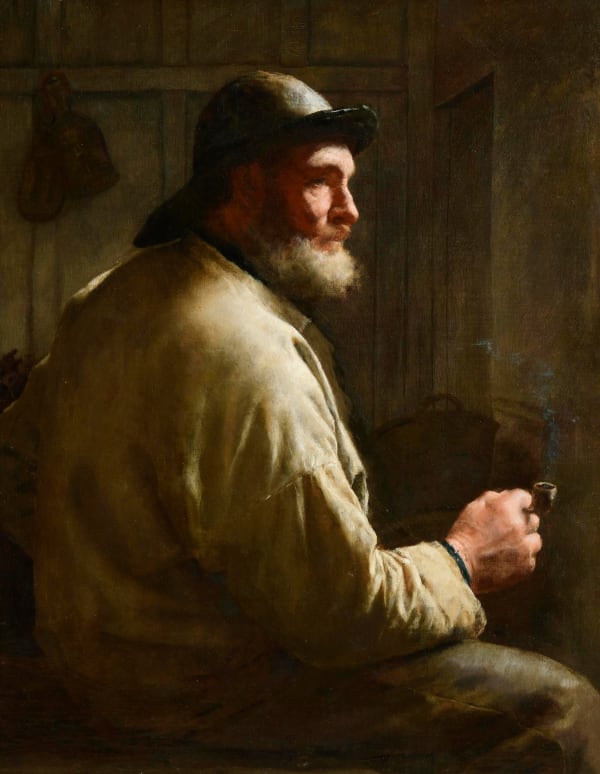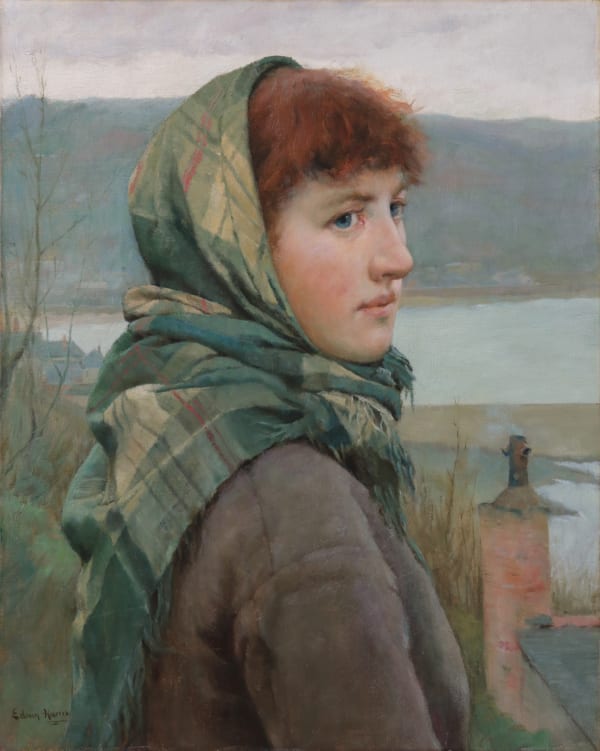Edwin Harris 1855-1906
-
 Edwin HarrisMiles away, c. 1885Oil on canvas38.1 x 30.5cm (12 x 15 ins.)
Edwin HarrisMiles away, c. 1885Oil on canvas38.1 x 30.5cm (12 x 15 ins.)
Framed: 52 x 44.5cm (20 1/2 x 17 1/2 ins)View full details -
 Edwin HarrisA Moment by the Fireside, 1891Oil on canvas laid to board48.9 x 39.4cm (19 1/4 x 15 1/2ins.)
Edwin HarrisA Moment by the Fireside, 1891Oil on canvas laid to board48.9 x 39.4cm (19 1/4 x 15 1/2ins.)
Framed: 69.4 x 59.9cm (27 5/16 x 23 9/16ins.)View full details -
 Edwin HarrisBetsy Lanyon, c. 1884Oil on canvas30.5 X 22.9 cm (12 x 9 ins.)
Edwin HarrisBetsy Lanyon, c. 1884Oil on canvas30.5 X 22.9 cm (12 x 9 ins.)
Framed: 49.0 x 41.0 cm (19.3 x 16.1 ins.)View full details -
 Edwin HarrisThe Fisherman's Rest, c. 1885Oil on canvas53.4 x 42 cm (21 x 16 1/2 ins.)Sold
Edwin HarrisThe Fisherman's Rest, c. 1885Oil on canvas53.4 x 42 cm (21 x 16 1/2 ins.)Sold
Framed: 72.3 x 61.0 cm (28 1/2 x 24 ins.)View full details -
 Edwin HarrisThe Draw Well, 1886Oil on canvas38.1 x 30.5 cm (15 x 12 ins)Sold
Edwin HarrisThe Draw Well, 1886Oil on canvas38.1 x 30.5 cm (15 x 12 ins)Sold
Framed: 49.3 x 42.5 cm (19 1/2 x 16 3/4 ins)View full details -
 Edwin HarrisBetsy Lanyon resting, c. 1885Oil on panel20.3 x 15.2cm (8 x 6ins.)Sold
Edwin HarrisBetsy Lanyon resting, c. 1885Oil on panel20.3 x 15.2cm (8 x 6ins.)Sold
Framed: 40.7 x 35cm (16 x 13.8 ins.)
View full details -
 Edwin HarrisAn Important Question, 1884Oil on canvas61 x 51cm (24 x 20in)Sold
Edwin HarrisAn Important Question, 1884Oil on canvas61 x 51cm (24 x 20in)Sold
Framed: 86.2 x 77.6cm (34 x 30 1/2 ins)View full details -
 Edwin HarrisA Summer Afternoon, 1885Oil on canvas50.8 x 40.6 cm (20 x 16 ins)Sold
Edwin HarrisA Summer Afternoon, 1885Oil on canvas50.8 x 40.6 cm (20 x 16 ins)Sold
Framed: 74.3 x 64 cm (29 1/4 x 25 1/4 ins)View full details -

"Mr Langley is generally regarded as the 'artistic father' of the small Cornish fishing village, but Mr Edwin Harris was before him, and is undoubtedly one of the first pioneers amongst the Newlynites." Harris's nineteenth century biographer.
Edwin Harris was born at Ladywood, Birmingham in 1855 and educated at Old Edgbaston School. In 1869 he entered Birmingham School of Art, aged fourteen. Fellow students included Walter Langley (with whom Harris was to pioneer the Newlyn colony of artists), William John Wainwright and William Breakspeare. At the Birmingham School, Harris was appointed assistant master and after two years set up his own studio, painting and teaching.
Having completed his studies and a short tenure teaching, Harris enrolled with John Wainwright at the Verlat’s Royal Academy of Antwerp in 1880. The friends’ Birmingham training served them well; Harris and Wainwright were selected to join the group of twelve elite students who were given a separate studio to work life size from the nude.
In Antwerp, Harris was greatly influenced by Charles Verlat, the Academy's Professor of Painting, who advocated a realist approach and working directly from nature, en plein-air. Keen to apply the skills he’d learned in Antwerp, Harris first travelled to Newlyn in 1881 and then onto Brittany, sponsored by the dealer Edwin Chamberlain, for two successive summers in 1881 and 1882. There he painted at the artists' colonies in Dinan and Pont-Aven. These Breton towns were a magnet for the new generation of en plein-air artists attracted partly by the low cost of living but more significantly, by the opportunity afforded to work outdoors recording the life of normal people in their natural environment. As Harris later described ‘… in those days there was hardly a village in Brittany which was not occupied by one or two painters, but at Pont Aven they simply swarmed.’ During his second Breton summer, in Pont-Aven, Harris met Elizabeth Armstrong, later Elizabeth Stanhope Forbes.
Harris married Sarah Chamberlain, niece of his Birmingham dealer Edwin Chamberlain and part of the wealthy and powerful Birmingham family. As Stanhope Forbes put it in 1884 ‘We had a very pleasant evening at the Harris’s yesterday and I was studiously polite to the dealer, who was a very quiet unassuming young man. He is Mrs Harris’s uncle. That’s a good idea to marry the niece of a dealer, especially when she is as nice as Mrs Harris.’
After a couple of ventures to Newlyn starting with the 1881 trip, Harris settled there with Sarah in 1883. Harris' nineteenth-century biographer credits him, rather than Walter Langley and with some bias, with being the first to adopt Newlyn, 'Mr Langley is generally regarded as the 'artistic father' of the small Cornish fishing village, but Mr Edwin Harris was before him, and is undoubtedly one of the first pioneers amongst the Newlynites'. In 1898 in the Magazine of Art, both painters were more reliably acknowledged as pioneers of the Newlyn colony, ‘It was Birmingham that first discovered Newlyn.’ Initially the ambition of the two artists was simply to find for themselves an English equivalent to their Breton retreats; as Langley said, what they had hoped would be their Pont Aven, and of which Stanhope Forbes later wrote, "a sort of English Concarneau." But this English Concarneau was to grow rapidly as an artists’ colony and with the addition of the likes of Forbes, Thomas Cooper Gotch, Frank Bramley, Fred Hall, Henry Scott Tuke, Chevalier Tayler, Elizabeth Armstrong and later Harold Harvey, Ernest and Dod Procter, it was to dominate the modern art scene in Britain through the turn of the century.
After a short stint in the nearby village of Paul, in 1884 the Harrises moved into Cliff Castle Cottage in Newlyn where their son was born that year. At Cliff Cottage the Harrises introduced Elizabeth Armstrong and Stanhope Forbes. Tragically the young family’s life together was short lived. Harris’s young wife died in 1887 at the age of only twenty-five, after being nursed during a short illness (consumption) by Elizabeth Armstrong and others in the growing colony.
After his wife's death, Harris moved with his son and a nurse to Belle Vue House, where Elizabeth and her mother also lodged. Forbes was also to join them there after he and Elizabeth were married.
Harris’s time in Brittany amid the burgeoning en plein-air colonies and their rural realism, was to become central to his and the Newlyn colony’s philosophy. However, as Roger Langley comments in ‘Edwin Harris. An Introduction to His Life and Art', and in contrast to Walter Langley, ’’In Newlyn Edwin Harris avoided the harshest realities of fishing life and chose more comfortable themes.’
Such early genre works like 'Mending the nets' and 'An Important Question' employ the characteristic square brush technique with exceptional skill, but it is his portraiture that singles him out among his Newlyn peers. 'A Summer Afternoon', 'The Fisherman's Rest’ and 'Miles Away' are such paintings showing Harris’s distinct skill in portraying the natural ease of his sitters going about their everyday lives in their native environments. The artist was equally adept painting his subjects indoors, usually with the Newlyn signature single light source such as that deployed in 'Betsy Lanyon’ (Harris’s model in ‘A sniff of snuff’, Penlee House Gallery and Museum) and outdoors as with the exquisite, ‘Under the Blossom’.
In 1895 Harris departed Newlyn meeting his second wife, Sally (nee Cornwell), a Penzance girl and mutual friend of Walter Langley. Harris spent the next three years, in Cardiff, Newport and Bristol before returning to the Midlands in 1898 where according to Forbes, he had inherited a country cottage. Throughout this period he concentrated almost exclusively on portraiture. Edwin Harris died, age 50, on 5 January 1906 in Cleeve Prior, near Evesham, Worcestershire.

